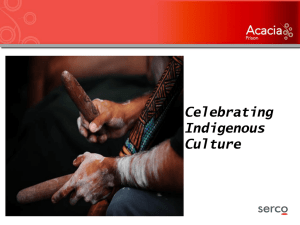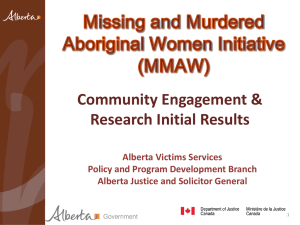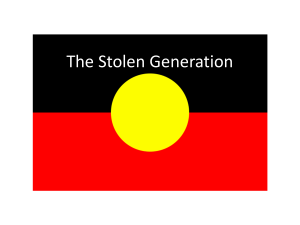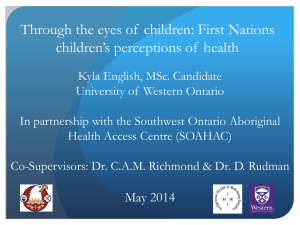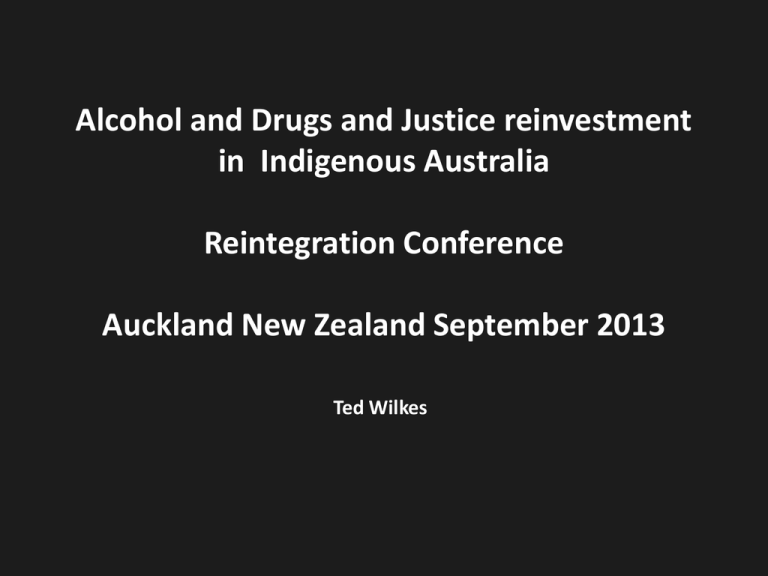
Alcohol and Drugs and Justice reinvestment
in Indigenous Australia
Reintegration Conference
Auckland New Zealand September 2013
Ted Wilkes
Kaya Nguny Djurapin
Wadjuk Nyungar Budja
• Wadjuk Nyungar………All the people of the
clans that are ancestral to the people from the
Derbarl Yerrigan (Swan River).
• Budja ………land
• Wargul…….. creator
The leading voice in Indigenous drug and alcohol policy advice
Impact of white colonization on
Aboriginal health today
Cultural genocide
Stolen children
Marginalization from
white society, poor
communication and
discrimination
COLONISATION
Loss of hunter-gatherer
Lifestyle, loss of culture
Poor nutrition
Poor housing,
Poor hygiene,
Overcrowding and
Infectious disease
Unemployment,
Poverty,
Poor education
Alcohol and
Substance abuse
Domestic violence,
Accidents, deaths
in custody
From Matthews 1997
Fixed settlements
Fringe camps
Urban ghettoes
Low birth weight,
Diabetes mellitus
Hypertension
Cardiovascular. disease
Respiratory disease,
Ear disease,
Rheumatic heart dis.
Renal disease
Pathways to Resilience
Personal achievement, social
competence and emotional
resilience
(Silburn, 2003)
Opportunities for achievement and
recognition of accomplishments
Responsive Parenting
(i.e. appropriate care
stimulation and
monitoring)
Genetic
factors
Optimal brain
development
in utero and
early childhood
Healthy pregnancy,
reduced maternal
smoking, alcohol
& drug misuse
Sense of selfefficacy & selfworth
Academic
success & other
achievements
Effective learning,
communication &
problem solving skills
Effective self regulation of
emotion, attention
& social interaction
Sense of
social
connectedness
Positive
interaction
with peers
Positive
interaction
with adults
Healthy beliefs
and clear
standards
Reduced
exposure
to harmful
drugs
Availability of +ve adult
role models & engaging
community activities
Social and economic environments supportive to child rearing – especially
absence of poverty and exposure to violence
Healthy nutrition in utero & throughout childhood & adolescence
Time
Pathways to Vulnerability
(Silburn, 2001)
Crime &
violence
Absence of
employment
Availability of
harmful drugs
Harmful drug &
alcohol use
Affiliation with
deviant peers
Low selfesteem
School &
learning
difficulties
Adverse
parenting &
exposure to
violence
Genetic
factors
Peer
problems
Self-regulation of
emotion, attention &
social interaction
Suicidal
behaviour
Depression
Increasing
psychosocial
difficulties
Acute stress
significant loss
Negative
thinking
patterns
Poor
problem
solving skills
Early neurological
(brain) development
Low SES, maternal
infections, drug use &
exposure to neurotoxins
Diet &
nutrition
Time
The National Indigenous Drug and Alcohol
Committee (NIDAC)
Established in 2004 by the Australian National
Council on Drugs (ANCD)
The ANCD is the principal advisory body on alcohol
and drug policy to the Prime Minister and the
Australian Government
NIDAC’s Key Roles and Responsibilities
As the leading voice in Indigenous alcohol and other
drug policy, NIDAC aims to identify and embrace
opportunities to influence decisions to reduce
alcohol and other drug problems and associated
harms in Indigenous communities nationally
It provides advice to the ANCD and Government
based on this collective expertise and experience,
as well as through ongoing consultation with those
working in the field, various stakeholders and
relevant experts
NIDAC Membership 2011 - 2014
Executive Committee Members
Associate Professor Ted Wilkes – NIDAC Chair - Curtin University (WA)
Mr Scott Wilson – NIDAC Deputy Chair - Aboriginal Drug and Alcohol
Council (SA)
Ms Wendy Casey - Aboriginal Alcohol and Other Drugs, Drug and Alcohol
Office (WA)
Ms Donna Ah Chee – CEO Central Australian Aboriginal Congress (NT)
Committee Members
Mr Matthew Bonson - Central Aboriginal Alcohol Program Services (CAAPS) (NT)
Ms Lisa Briggs - National Aboriginal Community Controlled Health Organisation (NACCHO) (ACT)
Ms Viki Briggs – National Centre for Excellence in Indigenous Tobacco Control (CEITC) (VIC)
Mr Bradley Freeburn – Aboriginal Medical Service , Redfern (NSW)
Professor Dennis Gray – National Drug Research Institute, Curtin University (WA)
Ms Kristie Harrison – Aboriginal Drug & Alcohol Network Leadership, Aboriginal Health & Medical
Research Council (ADAN , AHMRC) (NSW)
Dr John Herron – Australian National Council On Drugs (ANCD) Chairman (QLD)
Mr Romlie Mokak – Australian Indigenous Doctors’ Association (AIDA) (ACT)
Indigenous Australians in the justice system
NIDAC position paper - ‘Bridges and Barriers: Addressing
Indigenous Incarceration”
This paper highlights the high rates of incarceration of
Indigenous people:
26% of prisoners are Indigenous
Nationally, Indigenous people are 14 times more likely to be
imprisoned than non Indigenous
Increase of 343% for women in prison from time of the 1991 Royal
Commission into Aboriginal Deaths in Custody
49% of people in juvenile corrective institutions in 2010 -11 were
Indigenous
Prison Related Health Risks
Prison related health risks are much higher for all prisoners and
include issues such as:
Blood borne viruses – high risk behaviours including
injecting drug use, tattooing, physical violence, body piercing
and unprotected sex
Hep C virus is 30 times greater in prison than in general community
(Butler et al, 2011b)
Comorbidity – common among offenders
43% of subjects had suffered from a mental health disorder within
previous 12 mths
55% had a substance use disorder in previous 12 mths
29% prevalence of comorbidity
(Butler et al, 2011a)
Suicide and death from overdose (Hobbs et al, 2006)
Cost Benefit Analysis
NIDAC was well aware of the heath benefits for Indigenous
people being diverted away from prison but identified the
need for the cost benefit to be determined
NIDAC commissioned Deloitte Access Economics to
undertake this analysis comparing the costs associated with
prison vs residential treatment
Cost Benefit Analysis
Comparison of 2 alternative pathways were examined (prison pathway
and the residential rehabilitation pathway)
Target population - Indigenous offenders who were post trial, pre
sentence and faced possibility of going to prison, non violent with
problematic substance use issues who may benefit from diversion
Utilised ABS figures estimating the number of Indigenous Australians in
prison system, data on the numbers entering prison for non violent
offences and figures linking offending to AOD use
Number of prisons and costs associated with running them and number
of residential rehabs and their costs were also considered
Outcomes such as recidivism, health outcomes (mental health service
use, risk of contracting Hep C and drug relapse rates) were also
considered and factored into the calculations
Non financial benefits (improved mortality and quality of life) were also
considered
Key findings from Deloitte’s work
$111,000 per year/offender cost saving by diverting non violent
Indigenous offenders with substance use problems into Rx instead
of prison
Further $92,000/offender saving in the long term due to lower
mortality and better health related quality of life outcomes
In 2011 there were 115 correctional custodial facilities costing
$3b/annum (2010 -11 -capital and recurrent)
In 2009 – 10 there were 30 facilities providing residential drug and
alcohol treatment services for Indigenous people
Further detailed information on the findings can be accessed from the report, An economic analysis for
Aboriginal and Torres Strait Islander Offenders: Prison vs Residential Treatment
Time for a new approach
The Deloitte’s work shows:
Considerable benefits associated with the diversion of Indigenous prisoners into
community residential drug and alcohol rehabilitation services instead of incarceration
Financial savings as well as improvements in health and mortality
We know that imprisonment is not working for Indigenous people – it is
not able to address the underlying causes of offending
Need to start spending government funds in a smarter way
We know that diversion programs have huge benefits – avoid negative
labelling and stigma and reduce the number of people going back to
prison
Need to shift the investment from prisons to community based and
controlled services ( Justice Reinvestment)
JUSTICE REINVESTMENT IS
Justice Reinvestment involves a shift in spending NOT an
increase in spending
PRISON
PREVENTION
DON’T SPEND MORE, SPEND SMARTER
JUSTICE REINVESTMENT IS
Page Heading
Data
driven
Targeted to
increasing
community
safety
Place
based
Targeted to
reducing
offending &
imprisonment
Supported by
centralised
strategic
body
Fiscally
sound
Community Example of Justice Reinvestment
Bourke community approached NSW Justice Reinvestment
Campaign for Aboriginal Young People to develop a justice
reinvestment implementation plan
Bourke identified as having the highest number of breaches to bail
conditions in NSW; no residential AOD treatment services and lack
of AOD and MH services
Looked at young Aboriginal people aged 10 – 24 years (47 youth
identified)
Cost of incarceration for these youth estimated to be over
$2million
Funding could be used to establish programs such as youth
diversion and family case management
What NIDAC is seeking
NIDAC is calling on a justice reinvestment approach which
involves shifting part of the spending away from prisons
towards community-based programs and services that
address the factors that contribute to criminal behaviour
An inclusion of information on incarceration rates for
Indigenous men, women and young people in Closing the
Gap: Prime Minister’s Report, tabled annually in federal
parliament
The leading voice in Indigenous drug and alcohol policy advice
To obtain further information about
NIDAC, to obtain copies of reports or to
subscribe to NIDAC Weekly News visit
our website at : www.nidac.org.au
NIDAC Secretariat can be contacted on:
(02) 6166 9600 or nidac@ancd.org.au



